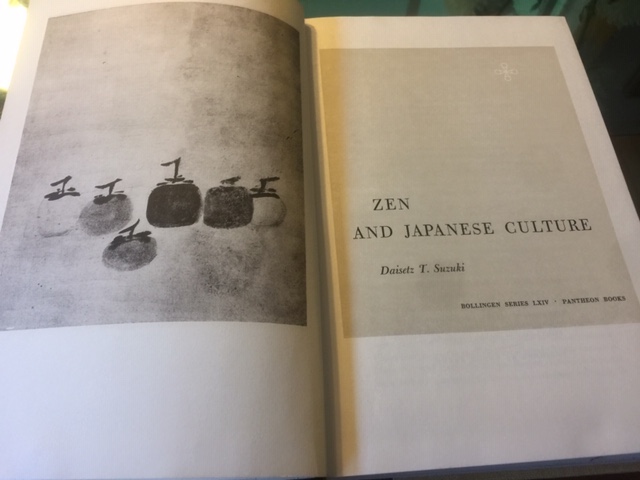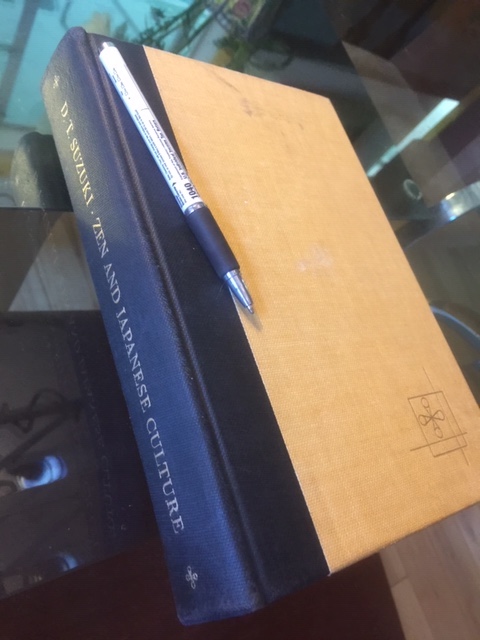The Zen of Publishing

HG scored this flea market book: Daisetz Suzuki’s Zen and Japanese Culture – a classic printed in hundreds of languages. This 1959 edition was published by the Bollingen Foundation, known for publishing books of significant impact since 1940. This title has always been of value in the market since its first printing in 1938.
In this 1959 edition, the author explains the revision of his classic: he begs the reader’s indulgence for adding 20 years of thoughts on Zen from 1938-1959 in three new chapters. The book’s title in 1939 was Zen Buddhism and Its Influence on Japanese Culture (pub. Eastern Buddhist Society of Otani Buddhist University at Kyoto). Instead of rewriting the book, Suzuki explains that he felt it important to include new chapters, integral to the understanding of Zen: Swordsmanship, The Art of Tea, and The Haiku. In those 20 years, he had become enamored of the relationship between those three topics and Zen. The new chapters are included in the section titled the “Japanese Love of Nature.”

Suzuki says: “The artist’s work is of free creation from intuitions directly … unhampered by senses and intellect. He creates forms and sounds out of formlessness and soundlessness.” Therefore, the 1959 edition is lavishly illustrated with ‘tipped in’ plates; photos of rock gardens, paintings since the 600’s, photos of shrines, and one amazing undocumented 18th century painting of the Buddha entering Nirvana under the trees; we see his mother Queen Maya carrying medicine with his disciple Mahākāśyapa, both arriving too late. All nature, human and non-human mourns; as Buddha dies, the trees burst into flower.
Zen and Japanese Culture has been an enduring classic because Suzuki’s carefully chosen prose is used to illustrate Zen itself. His language is simple and poetic as it describes 2,500 years of Buddhist history and relationship to Zen. He makes the case in both his prose style and his content (parables) that Zen is unique because Zen influences every part of life, not merely the spiritual.
Here’s a story from the book, written originally by Goso Hoyen (d. 1104). Suzuki writes, “If you must ask what Zen is like, I will say it is like learning the art of burglary: The son of an aging burglar asks to learn the art. Thus, the father takes the son on a burglary, and in the night during the act in the house, he locks his son into a large trunk, awakens the household, and leaves, unnoticed, to return home. The son lay in the trunk hating his father. He thought to make rat sounds; he was discovered and fled, hoisting a huge stone into the well in the courtyard as if to indicate his suicide therein. The master of the house and his sons dashed to the well, looked deep into the dark waters for the drowning burglar. All became quiet. All over.
“Returning to his father’s house, the young burglar accosted his father ‘Father, WHY??’ His father said, ‘Son, don’t be offended, just tell me how you got out of the situation.’ Which the son did, and upon hearing his escape, the father said, ‘There you are, son. You have learned the art.’” Suzuki comments on this parable: “Satori (enlightenment) must be an outgrowth of one’s inner life, and not brought about from the outside.”
The publisher, the Bollingen Foundation, was remarkable: it was founded by a husband-and-wife team in 1940, and over many years till 2002 the foundation awarded fellowships and an annual prize for poetry. The foundation had published 275 titles including the Wilhelm/Baynes translation of the I Ching, or Book of Changes; D. T. Suzuki’s Zen and Japanese Culture; Vladimir Nabokov’s translation of Pushkin’s Eugene Onegin; Erich Neumann’s The Origins and History of Consciousness; Mircea Eliade’s The Myth of the Eternal Return; Isaiah Berlin’s The Origins of Romanticism; Gershom Scholem’s Sabbatai Sevi; E. H. Gombrich’s Art and Illusion; andKenneth Clark’s The Nude.
This book was a gift: on the flyleaf, there’s a beautifully penned inscription from a friend named Shirley to Ann. This short haiku is taken from the book itself: “To Ann: If your eyes see,/ and ears hear,/ not a doubt you’ll cherish,/ How naturally the rain drips from the leaves!” Indeed, throughout the book Suzuki elegantly analyzes haiku such as this. Here is my favorite – what I consider a symphony in simple green after a rainfall: “A solitary frog drenched in rain,/ Rides on a Basho leaf,/ Unsteadily.”
The value of the flea market treasure is $100.







You must be logged in to post a comment.